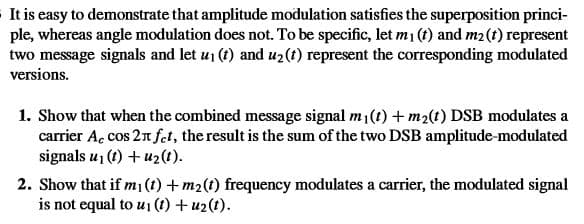It is easy to demonstrate that amplitude modulation satisfies the superposition princi- ple, whereas angle modulation does not. To be specific, let m1 (t) and m2(t) represent two message signals and let u1 (t) and uz(t) represent the corresponding modulated versions. 1. Show that when the combined message signal m1(t) +m2(t) DSB modulates a carrier A. cos 2n fet, the result is the sum of the two DSB amplitude-modulated signals u, (1) + u2(t). 2. Show that if m¡ (t) + m2(t) frequency modulates a carrier, the modulated signal is not equal to u¡ (t) + u2(t).
It is easy to demonstrate that amplitude modulation satisfies the superposition princi- ple, whereas angle modulation does not. To be specific, let m1 (t) and m2(t) represent two message signals and let u1 (t) and uz(t) represent the corresponding modulated versions. 1. Show that when the combined message signal m1(t) +m2(t) DSB modulates a carrier A. cos 2n fet, the result is the sum of the two DSB amplitude-modulated signals u, (1) + u2(t). 2. Show that if m¡ (t) + m2(t) frequency modulates a carrier, the modulated signal is not equal to u¡ (t) + u2(t).
Introductory Circuit Analysis (13th Edition)
13th Edition
ISBN:9780133923605
Author:Robert L. Boylestad
Publisher:Robert L. Boylestad
Chapter1: Introduction
Section: Chapter Questions
Problem 1P: Visit your local library (at school or home) and describe the extent to which it provides literature...
Related questions
Question

Transcribed Image Text:It is easy to demonstrate that amplitude modulation satisfies the superposition princi-
ple, whereas angle modulation does not. To be specific, let m1 (t) and m2(t) represent
two message signals and let u1 (t) and uz(t) represent the corresponding modulated
versions.
1. Show that when the combined message signal m1(t) +m2(t) DSB modulates a
carrier A. cos 2n fet, the result is the sum of the two DSB amplitude-modulated
signals u, (1) + u2(t).
2. Show that if m¡ (t) + m2(t) frequency modulates a carrier, the modulated signal
is not equal to u¡ (t) + u2(t).
Expert Solution
This question has been solved!
Explore an expertly crafted, step-by-step solution for a thorough understanding of key concepts.
This is a popular solution!
Trending now
This is a popular solution!
Step by step
Solved in 3 steps with 6 images

Recommended textbooks for you

Introductory Circuit Analysis (13th Edition)
Electrical Engineering
ISBN:
9780133923605
Author:
Robert L. Boylestad
Publisher:
PEARSON

Delmar's Standard Textbook Of Electricity
Electrical Engineering
ISBN:
9781337900348
Author:
Stephen L. Herman
Publisher:
Cengage Learning

Programmable Logic Controllers
Electrical Engineering
ISBN:
9780073373843
Author:
Frank D. Petruzella
Publisher:
McGraw-Hill Education

Introductory Circuit Analysis (13th Edition)
Electrical Engineering
ISBN:
9780133923605
Author:
Robert L. Boylestad
Publisher:
PEARSON

Delmar's Standard Textbook Of Electricity
Electrical Engineering
ISBN:
9781337900348
Author:
Stephen L. Herman
Publisher:
Cengage Learning

Programmable Logic Controllers
Electrical Engineering
ISBN:
9780073373843
Author:
Frank D. Petruzella
Publisher:
McGraw-Hill Education

Fundamentals of Electric Circuits
Electrical Engineering
ISBN:
9780078028229
Author:
Charles K Alexander, Matthew Sadiku
Publisher:
McGraw-Hill Education

Electric Circuits. (11th Edition)
Electrical Engineering
ISBN:
9780134746968
Author:
James W. Nilsson, Susan Riedel
Publisher:
PEARSON

Engineering Electromagnetics
Electrical Engineering
ISBN:
9780078028151
Author:
Hayt, William H. (william Hart), Jr, BUCK, John A.
Publisher:
Mcgraw-hill Education,